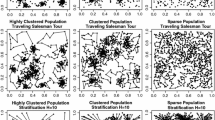Abstract.
Very often values of a size variable are known for the elements of a population we want to sample. For example, the elements may be clusters, the size variable denoting the number of units in a cluster. Then, it is quite usual to base the selection of elements on inclusion probabilities which are proportionate to the size values. To estimate the total of all values of an unknown variable for the units in the population of interest (i.e. for the units contained in the clusters) we may use weights, e.g. inverse inclusion probabilities. We want to clarify these ideas by the minimax principle. Especially, we will show that the use of inclusion probabilities equal to 1 is recommendable for units with high values of the size measure.
Similar content being viewed by others
Author information
Authors and Affiliations
Corresponding author
Additional information
AMS Classification 2000: Primary 62D05. Secondary 62C20
Rights and permissions
About this article
Cite this article
Stenger, H., Gabler, S. Combining random sampling and census strategies - Justification of inclusion probabilities equal to 1. Metrika 61, 137–156 (2005). https://doi.org/10.1007/s001840400328
Issue Date:
DOI: https://doi.org/10.1007/s001840400328




